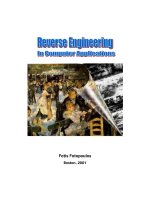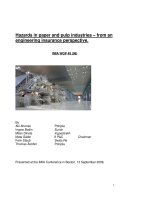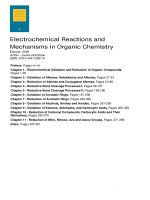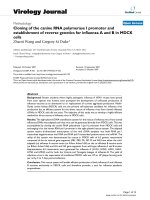Bioinspiration and biomimicry in chemistry reverse engineering nature
Bạn đang xem bản rút gọn của tài liệu. Xem và tải ngay bản đầy đủ của tài liệu tại đây (10.74 MB, 526 trang )
BIOINSPIRATION
AND BIOMIMICRY
IN CHEMISTRY
BIOINSPIRATION
AND BIOMIMICRY
IN CHEMISTRY
REVERSE-ENGINEERING NATURE
Edited by
Gerhard F. Swiegers
A JOHN WILEY & SONS, INC., PUBLICATION
Copyright © 2012 by John Wiley & Sons, Inc. All rights reserved
Published by John Wiley & Sons, Inc., Hoboken, New Jersey
Published simultaneously in Canada
No part of this publication may be reproduced, stored in a retrieval system, or transmitted in any form
or by any means, electronic, mechanical, photocopying, recording, scanning, or otherwise, except as
permitted under Section 107 or 108 of the 1976 United States Copyright Act, without either the prior
written permission of the Publisher, or authorization through payment of the appropriate per-copy fee
to the Copyright Clearance Center, Inc., 222 Rosewood Drive, Danvers, MA 01923, (978) 750-8400,
fax (978) 750-4470, or on the web at www.copyright.com. Requests to the Publisher for permission
should be addressed to the Permissions Department, John Wiley & Sons, Inc., 111 River Street,
Hoboken, NJ 07030, (201) 748-6011, fax (201) 748-6008, or online at
/>Limit of Liability/Disclaimer of Warranty: While the publisher and author have used their best efforts
in preparing this book, they make no representations or warranties with respect to the accuracy or
completeness of the contents of this book and specifically disclaim any implied warranties of
merchantability or fitness for a particular purpose. No warranty may be created or extended by sales
representatives or written sales materials. The advice and strategies contained herein may not be
suitable for your situation. You should consult with a professional where appropriate. Neither the
publisher nor author shall be liable for any loss of profit or any other commercial damages, including
but not limited to special, incidental, consequential, or other damages.
For general information on our other products and services or for technical support, please contact our
Customer Care Department within the United States at (800) 762-2974, outside the United States at
(317) 572-3993 or fax (317) 572-4002.
Wiley also publishes its books in a variety of electronic formats. Some content that appears in print
may not be available in electronic formats. For more information about Wiley products, visit our web
site at www.wiley.com.
Library of Congress Cataloging-in-Publication Data:
Bioinspiration and biomimicry in chemistry : reverse-engineering nature /
edited by Gerhard F. Swiegers.
p. cm.
Includes bibliographical references and index.
ISBN 978-0-470-56667-1 (cloth)
1. Biomimicry. 2. Biomimetics. 3. Biomedical engineering. 4. Biomedical
materials. I. Swiegers, Gerhard F.
QP517.B56B478 2012
610.28–dc23
2011049801
Printed in the United States of America
10 9 8 7 6 5 4 3 2 1
Dedicated to Crawford Long, William Thomas Green Morton,
and Wilhelm R¨ontgen
CONTENTS
Foreword
xvii
Foreword
xix
Jean-Marie Lehn
Janine Benyus
Preface
xxiii
Contributors
xxv
1. Introduction: The Concept of Biomimicry and Bioinspiration
in Chemistry
1
Timothy W. Hanks and Gerhard F. Swiegers
1.1
What is Biomimicry and Bioinspiration?
1
1.2
Why Seek Inspiration from, or Replicate Biology?
3
1.2.1
1.2.2
1.2.3
1.3
Biomimicry and Bioinspiration as a Means
of Learning from Nature and Reverse-Engineering
from Nature
Biomimicry and Bioinspiration as a Test of Our
Understanding of Nature
Going Beyond Biomimicry and
Bioinspiration
3
4
4
Other Monikers: Bioutilization, Bioextraction, Bioderivation,
and Bionics
5
1.4
Biomimicry and Sustainability
5
1.5
Biomimicry and Nanostructure
7
1.6
Bioinspiration and Structural Hierarchies
9
1.7
Bioinspiration and Self-Assembly
11
1.8
Bioinspiration and Function
12
1.9
Future Perspectives: Drawing Inspiration from the Complex
System that is Nature
13
References
14
vii
viii
CONTENTS
2. Bioinspired Self-Assembly I: Self-Assembled Structures
17
Leonard F. Lindoy, Christopher Richardson, and Jack K. Clegg
2.1
Introduction
17
2.2
Molecular Clefts, Capsules, and Cages
19
2.2.1
2.2.2
Organic Cage Systems
Metallosupramolecular Cage Systems
21
24
Enzyme Mimics and Models: The Example of Carbonic
Anhydrase
28
2.4
Self-Assembled Liposome-Like Systems
30
2.5
Ion Channel Mimics
32
2.6
Base-Pairing Structures
34
2.7
DNA–RNA Structures
36
2.8
Bioinspired Frameworks
38
2.9
Conclusion
41
References
41
2.3
3. Bioinspired Self-Assembly II: Principles of Cooperativity
in Bioinspired Self-Assembling Systems
47
Gianfranco Ercolani and Luca Schiaffino
3.1
Introduction
47
3.2
Statistical Factors in Self-Assembly
48
3.3
Allosteric Cooperativity
50
3.4
Effective Molarity
52
3.5
Chelate Cooperativity
55
3.6
Interannular Cooperativity
60
3.7
Stability of an Assembly
62
3.8
Conclusion
67
References
67
4. Bioinspired Molecular Machines
71
Christopher R. Benson, Andrew I. Share, and Amar H. Flood
4.1
Introduction
4.1.1
Inspirational Antecedents: Biology, Engineering,
and Chemistry
71
72
CONTENTS
4.1.2
4.1.3
4.2
Chemical Integration
Chapter Overview
ix
75
77
Mechanical Effects in Biological Machines
78
4.2.1
4.2.2
4.2.3
4.2.4
4.2.5
4.2.6
78
79
80
82
83
Skeletal Muscle’s Structure and Function
Kinesin
F1 -ATP Synthase
Common Features of Biological Machines
Variation in Biomotors
Descriptions and Analogies of Molecular
Machines
83
4.3
Theoretical Considerations: Flashing Ratchets
83
4.4
Sliding Machines
86
4.4.1
4.4.2
86
4.4.3
4.4.4
4.5
Linear Machines: Rotaxanes
Mechanistic Insights: Ex Situ and In Situ
(Maxwell’s Demon)
Bioinspiration in Rotaxanes
Molecular Muscles as Length Changes
89
93
93
Rotary Motors
102
4.5.1
4.5.2
103
104
Interlocked Rotary Machines: Catenanes
Unimolecular Rotating Machines
4.6
Moving Larger Scale Objects
104
4.7
Walking Machines
106
4.8
Ingenious Machines
109
4.8.1
4.8.2
4.8.3
Molecular Machines Inspired by Macroscopic
Ones: Scissors and Elevators
Artificial Motility at the Nanoscale
Moving Molecules Across Surfaces
109
109
110
4.9
Using Synthetic Bioinspired Machines in Biology
111
4.10
Perspective
111
4.10.1
4.10.2
4.11
Lessons and Departures from Biological Molecular
Machines
The Next Steps in Bioinspired Molecular
Machinery
114
115
Conclusion
116
References
116
x
CONTENTS
5. Bioinspired Materials Chemistry I: Organic–Inorganic
Nanocomposites
121
Pilar Aranda, Francisco M. Fernandes, Bernd Wicklein, Eduardo
Ruiz-Hitzky, Jonathan P. Hill, and Katsuhiko Ariga
5.1
Introduction
121
5.2
Silicate-Based Bionanocomposites as Bioinspired
Systems
122
5.3
Bionanocomposite Foams
124
5.4
Biomimetic Membranes
126
5.4.1
5.4.2
126
5.5
Hierarchically Layered Composites
5.5.1
5.5.2
5.6
Phospholipid–Clay Membranes
Polysaccharide–Clay Bionanocomposites as
Support for Viruses
Layer-by-Layer Assembly of Composite-Cell
Model
Hierarchically Organized Nanocomposites
for Sensor and Drug Delivery
127
129
129
130
Conclusion
133
References
134
6. Bioinspired Materials Chemistry II: Biomineralization
as Inspiration for Materials Chemistry
139
Fabio Nudelman and Nico A. J. M. Sommerdijk
6.1
Inspiration from Nature
139
6.2
Learning from Nature
144
6.3
Applying Lessons from Nature: Synthesis of Biomimetic
and Bioinspired Materials
146
6.3.1
6.3.2
6.3.3
147
151
157
6.4
Biomimetic Bone Materials
Semiconductors, Nanoparticles, and Nanowires
Biomimetic Strategies for Silica-Based Materials
Conclusion
160
References
160
7. Bioinspired Catalysis
165
Gerhard F. Swiegers, Jun Chen, and Pawel Wagner
7.1
Introduction
165
CONTENTS
xi
7.2
A General Description of the Operation of Catalysts
168
7.3
A Brief History of Our Understanding
of the Operation of Enzymes
169
7.3.1
7.3.2
7.3.3
7.3.4
7.3.5
7.3.6
7.4
170
170
172
172
173
174
177
Important General Characteristics of Enzymes as a
Class of Catalyst
Bioinspired/Biomimetic Catalysts that Illustrate the
Critical Importance of Reactant Approach
Trajectories
178
7.4.3
Bioinspired/Biomimetic Catalysts that Demonstrate
the Importance and Limitations of Molecular
Recognition
182
7.4.4
Bioinspired/Biomimetic Catalysts that Operate Like
a Mechanical Device
187
7.4.2
7.6
The Fundamental Origin of Machine-like Actions:
Mechanical Catalysis
Representative Studies of Bioinspired/Biomimetic
Catalysts
7.4.1
7.5
Early Proposals: Lock-and-Key Theory, Strain
Theory, and Induced Fit Theory
The Critical Role of Molecular Recognition
in Enzymatic Catalysis: Pauling’s Concept of
Transition State Complementarity
The Critical Role of Approach Trajectories
in Enzymatic Catalysis: Orbital Steering, Near
Attack Conformers, the Proximity Effect, and
Entropy Traps
The Critical Role of Conformational Motion
in Enzymatic Catalysis: Coupled Protein Motions
Enzymes as Molecular Machines: Dynamic
Mechanical Devices and the Entatic State
177
The Relationship Between Enzymatic Catalysis and
Nonbiological Homogeneous and Heterogeneous
Catalysis
192
Selected High-Performance NonBiological Catalysts that
Exploit Nature’s Catalytic Principles
193
7.6.1
7.6.2
Adapting Model Species of Enzymes to Facilitate
Machine-like Catalysis
Statistical Proximity Catalysts
194
201
xii
CONTENTS
7.7
Conclusion: The Prospects for Harnessing Nature’s Catalytic
Principles
203
References
204
8. Biomimetic Amphiphiles and Vesicles
209
Sabine Himmelein and Bart Jan Ravoo
8.1
Introduction
209
8.2
Synthetic Amphiphiles as Building Blocks for Biomimetic
Vesicles
210
8.3
Vesicle Fusion Induced by Molecular Recognition
216
8.4
Stimuli-Responsive Shape Control of Vesicles
224
8.5
Transmembrane Signaling and Chemical Nanoreactors
231
8.6
Toward Higher Complexity: Vesicles with
Subcompartments
239
Conclusion
245
References
246
8.7
9. Bioinspired Surfaces I: Gecko-Foot Mimetic Adhesion
251
Liangti Qu, Yan Li, and Liming Dai
9.1
The Hierarchical Structure of Gecko Feet
251
9.2
Origin of Adhesion in Gecko Setae
252
9.3
Structural Requirements for Synthetic Dry Adhesives
253
9.4
Fabrication of Synthetic Dry Adhesives
254
9.4.1
9.4.2
254
278
9.5
Polymer-Based Dry Adhesives
Carbon-Nanotube-Based Dry Adhesives
Outlook
284
References
286
10. Bioinspired Surfaces II: Bioinspired Photonic Materials
293
Cun Zhu and Zhong-Ze Gu
10.1
Structural Color in Nature: From Phenomena to Origin
293
10.2
Bioinspired Photonic Materials
296
10.2.1
10.2.2
297
The Fabrication of Photonic Materials
The Design and Application of Photonic
Materials
298
CONTENTS
10.3
xiii
Conclusion and Outlook
317
References
319
11. Biomimetic Principles in Macromolecular Science
323
Wolfgang H. Binder, Marlen Schunack, Florian Herbst, and
Bhanuprathap Pulamagatta
11.1
Introduction
323
11.2
Polymer Synthesis Versus Biopolymer Synthesis
325
11.2.1
11.2.2
11.2.3
325
326
11.3
11.4
330
11.3.1
11.3.2
11.3.3
11.3.4
330
333
334
337
Helically Organized Polymers
β-Sheets
Supramolecular Polymers
Self-Assembly of Block Copolymers
Movement in Polymers
343
Polymer Gels and Networks as Chemical
Motors
Polymer Brushes and Lubrication
Shape-Memory Polymers
343
346
349
Antibody-Like Binding and Enzyme-Like Catalysis
in Polymeric Networks
352
Self-Healing Polymers
355
References
362
11.4.2
11.4.3
11.6
328
Biomimetic Structural Features in Synthetic Polymers
11.4.1
11.5
Features of Polymer Synthesis
“Living” Chain Growth
Aspects of Chain Length Distribution in Synthetic
Polymers: Sequence Specificity and Templating
12. Biomimetic Cavities and Bioinspired Receptors
367
St´ephane Le Gac, Ivan Jabin, and Olivia Reinaud
12.1
Introduction
367
12.2
Mimics of the Michaelis–Menten Complexes of Zinc(II)
Enzymes with Polyimidazolyl Calixarene-Based Ligands
368
12.2.1
12.2.2
A Bis-aqua Zn(II) Complex Modeling the Active
Site of Carbonic Anhydrase
Structural Key Features of the Zn(II) Funnel
Complexes
369
371
xiv
CONTENTS
12.2.3
12.2.4
12.2.5
12.2.6
12.3
Combining a Hydrophobic Cavity and A Tren-Based Unit:
Design of Tunable, Versatile, but Highly Selective
Receptors
12.3.1
12.3.2
12.3.3
12.3.4
12.4
Tren-Based Calix[6]arene Receptors
Versatility of a Polyamine Site
Polyamido and Polyureido Sites for Synergistic
Binding of Dipolar Molecules and Anions
Acid–Base Controllable Receptors
Self-Assembled Cavities
12.4.1
12.4.2
12.4.3
12.4.4
12.5
Hosting Properties of the Zn(II) Funnel Complexes:
Highly Selective Receptors for Neutral Molecules
Induced Fit: Recognition Processes Benefit from
Flexibility
Multipoint Recognition
Implementation of an Acid–Base Switch for Guest
Binding
Receptors Decorated with a Triscationic or a
Trisanionic Binding Site
Receptors Capped Through Assembly with a
Tripodal Subunit
Heteroditopic Self-Assembled Receptors with
Allosteric Response
Interlocked Self-Assembled Receptors
372
373
374
375
377
377
378
380
383
383
384
387
388
389
Conclusion
391
References
392
13. Bioinspired Dendritic Light-Harvesting Systems
397
Andrea M. Della Pelle and Sankaran Thayumanavan
13.1
Introduction
397
13.2
Dendrimer Architectures
399
13.2.1
13.2.2
399
401
13.3
13.4
Dendrimer as a Chromophore
Dendrimer as a Scaffold
Electronic Processes in Light-Harvesting Dendrimers
403
13.3.1
13.3.2
403
405
Energy Transfer in Dendrimers
Charge Transfer in Dendrimers
Light-Harvesting Dendrimers in Clean Energy
Technologies
407
CONTENTS
13.5
xv
Conclusion
413
References
414
14. Biomimicry in Organic Synthesis
419
Reinhard W. Hoffmann
14.1
Introduction
419
14.2
Biomimetic Synthesis of Natural Products
420
14.2.1
Potentially Biomimetic Synthesis
423
14.3
Biomimetic Reactions in Organic Synthesis
437
14.4
Biomimetic Considerations as an Aid in Structural
Assignment
447
Reflections on Biomimicry in Organic Synthesis
448
References
450
14.5
15. Conclusion and Future Perspectives: Drawing Inspiration from
the Complex System that Is Nature
455
Clyde W. Cady, David M. Robinson, Paul F. Smith, and
Gerhard F. Swiegers
15.1
Introduction: Nature as a Complex System
455
15.2
Common Features of Complex Systems and the Aims
of Systems Chemistry
457
Examples of Research in Systems Chemistry
460
15.3
15.3.1
15.3.2
15.3.3
15.4
Index
Self-Replication, Amplification, and
Feedback
Emergence, Evolution, and the Origin
of Life
Autonomy and Autonomous Agents: Examples
of Equilibrium and Nonequilibrium Systems
460
464
465
Conclusion: Systems Chemistry may have Implications
in Other Fields
468
References
470
473
FOREWORD
The highest level of complexity of matter is that expressed in living matter, the
substances and processes supporting life. In the course of evolution from nonliving
to living matter, more and more complex forms of matter have been generated. Life
has funneled molecular systems into specific types and improved their functions
toward efficiency and selectivity as high as required for the operation of the full
living organism.
Describing these highly efficient and selective systems and understanding their
functioning is a challenge for chemistry. It involves designing mimics that help to
unravel how these natural systems work. But, as important and in fact of wider significance is to go beyond models and implement on the wider scene the knowledge
gained through mimicry to explore on one hand how similar functional features
may be borne by different structures and, on the other, to show that novel functions of similar or even higher efficiencies and selectivities may be evolved in
synthetic, nonnatural systems. Thus, mimicry of biological processes is crucial in
first progressing toward understanding them and then going beyond.
Chemistry and in particular supramolecular chemistry entertain a double relationship with biology. Numerous studies are concerned with substances and processes
of a biological or biomimetic nature. The scrutinization of biological processes
by chemists has led to the development of models for understanding them on a
molecular basis and of suitably designed effectors for acting on them.
On the other hand, the challenge for chemistry lies in the development of abiotic,
nonnatural systems, figments of the imagination of the chemist, displaying desired
structural features and carrying out functions other than those present in biology
with comparable efficiency and selectivity. Not limited by the constraints of living
organisms, abiotic chemistry is free to invent new substances and processes. The
field of chemistry is indeed broader than that of the systems actually realized in
Nature.
Supramolecular chemistry has been following both paths. Molecular recognition, catalysis, and transport processes are the basic functions investigated on both
the biomimetic and abiotic fronts over the years. As recognition implies information, supramolecular chemistry has brought forward the concept that chemistry is
also an information science, information being stored at the molecular level and
processed at the supramolecular level. On this basis, supramolecular chemistry is
actively exploring systems undergoing self-organization, that is, systems capable
of generating, spontaneously but in an information-controlled manner, well-defined
xvii
xviii
FOREWORD
functional architectures by self-assembly from their components, thus behaving as
programmed chemical systems.
The realization that supramolecular chemistry is intrinsically a dynamic
chemistry in view of the lability of the interactions connecting the molecular
components of a supramolecular entity led to the emergence of the concept of
constitutional dynamic chemistry (CDC) that extended these dynamic features
also to the molecular level. Dynamic entities are thus able to exchange their
components by reversible formation or breaking of noncovalent interactions or of
reversible covalent bonds, therefore allowing a continuous change in constitution
by reorganization and exchange of building blocks.
CDC introduces a paradigm shift with respect to constitutionally static chemistry and takes advantage of dynamic diversity to allow variation and selection.
The implementation of selection in chemistry introduces a fundamental change
in outlook. Whereas self-organization by design strives to achieve full control
over the output molecular or supramolecular entity by explicit programming, selforganization with selection operates on dynamic constitutional diversity in response
to either internal or external factors to achieve adaptation in a Darwinian way.
Synthetic systems are thus moving toward an adaptive and evolutive chemistry.
Along the way, the chemist finds illustration, inspiration, and stimulation in
biological processes, as well as confidence and reassurance since they are proof
that such fantastic complexity of structure and function can be achieved on the basis
of molecular components. The mere fact that biological systems exist demonstrates
that such a complexity can indeed exist in the world of molecules, despite our
present inability to understand how it operates and how it has come about. Indeed,
the molecular world of biology is only one of all the possible worlds of the universe
of chemistry, that await to be created at the hands of the chemist!
It has been my privilege and pleasure to have participated in the development of
bioinspiration and biomimicry in chemistry, and in the steps beyond, over the last
40 years. This field has made striking progress, but it still has much to teach us.
I recommend it to you, the reader, for the promise and stimulation it holds. I wish
to warmly congratulate the authors of this volume for their efforts in presenting
the realizations and the perspectives of this most inspiring frontier of science.
Jean-Marie Lehn
FOREWORD
In the years since Biomimicry: Innovation Inspired by Nature chronicled the rise of
a new design discipline,1 the number of bioinspired patents, products, and practitioners has steadily risen. Each year, new biomimetic research centers open, more
students take biomimetics courses, and more Fortune 500 companies invite biomimics to their design tables. In a study of U.S. patents between 1985 and 2005, Richard
Bonser of the University of Bath found that patents with “biomimetic” or “bioinspired” in the title increased by a factor of 93, against a 2.7 times rise in other
patents.2 Why this surge of interest in Nature’s designs?
I believe our species has begun to sense and respond to the same set of selection pressures that other organisms have faced for 3.8 billion years. As energy
prices climb, chemists are asked to dial back temperatures and pressures while
minimizing processing steps. Peaking supplies of nonrenewable feedstocks prompt
calls for higher selectivity and atom economy, while focus shifts to renewable
and waste-derived feedstocks. Meanwhile, regulatory laws oblige companies to
minimize hazardous emissions and, in some countries, to take responsibility for
long-term toxicological effects. In this perfect storm for change, conscientious consumers, governments, and corporations are demanding safer and more sustainable
chemistry.
Life on earth has operated under these strict guidelines for billions of years.
Organisms don’t have the luxury of buying their chemicals from a manufacturing
facility; they are the facility. Chemistry is performed in or near an organism’s
living tissues, and the by-products are released not just to any environment, but to
the very habitat that must nurture the organism’s offspring.
Life has had to perform this in situ chemistry without high temperatures, organic
solvents, hazardous reagents, or extremes of pH. The feedstocks of choice are
renewable or waste derived, procured locally and used judiciously. Compared to
industry’s use of the entire periodic table (even the toxic elements), the rest of life
uses only a small subset of elements as grist for an astounding variety of functional
molecules, structures, and materials. The feedstocks are few, the reactions are
aqueous and elegant, and recyclability is built in though a process of anabolism
and catabolism. Life’s processes are proof that chemistry can occur under mild, lifefriendly conditions, with an impressive degree of efficiency, selectivity, chemical
yield, purity, and end of life reuse.
This realization dawns at an important moment in the history of sustainable
chemistry. The first decades of safer chemistry featured lists of substances to avoid
and challenged chemists to find alternatives to individual compounds. With more
xix
xx
FOREWORD
than 100,000 synthetic chemicals on the market, this compound-by-compound substitution has not kept pace. To overcome this limitation, bioinspired chemists should
spend the coming decades moving upstream in the design process, finding alternatives for whole families of chemical reactions, not just compounds.3 Rather
than designing for acceptable risk, or writing containment protocols for questionable substances, young chemists should look forward to a career-long challenge of
replacing industry’s recipe book with Nature’s own.
Pledging to work as Nature does—within planetary boundaries—is in no
way a limit on creativity. In fact, the relatively unexplored space of biological
chemistry—the process strategies of 30 million species—is broad and inspiring.
A design brief that specifies no “heat, beat, and treat,” no waste, and no rare or
toxic materials serves as a creative frame, allowing us to achieve what we might
not have imagined.
One example is a kiln-free route to high-tech ceramics. During the oil shocks of
the 1970s, Jeffrey Brinker of Sandia National Labs was asked by his supervisor if
he could make ceramics without fossil fuels. Brinker’s research led him to mimic
nacre, the iridescent lining of the abalone’s shell. This layered nanocomposite is
twice as tough as our jet engine ceramics thanks to the inclusion of polymer interlayers between the calcium carbonate layers. After nucleating crystal formation, the
polymer allows the nacre to slide like a metal under compression, and under tension, the polymer stretches and self-heals. Our conventional kiln-based processes
would have burned off this essential organic component, and with it, step changes
in performance and functionality. In the same way, Nature’s habit of “building from
the bottom up” confers a strategic advantage. Templated self-assembly gives rise to
long-range, hierarchical order, with surprising ancillary effects such as functional
gradients and built-in redundancy from molecule to biosystem. Building to shape
rather than subtractive cutting and grinding is inherently waste-free, a welcome
change in an economy where most manufactured products yield 93% waste and
only 7% product.4
Biomimetic companies are beginning to reverse this equation in several breakthrough products. Novomer has designed a photosynthesis-inspired catalyst that
combines CO2 and limonene to create biodegradable polycarbonates in a lowtemperature process.5 Calera has borrowed the recipe from corals to turn flue-gas
CO2 and seawater into a cement alternative that sequesters a half ton of CO2 for
every ton of cement.6 Biomatrica has mimicked the anhydrobiosis chemistry of
tardigrades to create a new way of storing biologicals without refrigeration, significantly reducing energy use in research labs, hospitals, and vaccine cold chains.7
AQUAporin is making desalination membranes studded with life’s water-escorting
aquaporin molecules to increase rates of permeability by 100 times.8 Donlar Corporation’s TPA product reduces mineral scaling in pipes by borrowing the principles
of mollusk stop proteins which limit seashell size.9 Mussel glue has also been
mimicked, allowing Columbia Forest Products to market a plywood resin that
replaces more than 47 million pounds of formaldehyde-based adhesive annually.10
Biosignal researchers found a resistance-free way to prevent biofilms by mimicking
furonones—compounds that red algae use to interrupt bacterial signaling.11 Several
FOREWORD
xxi
companies are working to replicate the self-cleaning properties of lotus leaves, and
Big Sky Technologies has learned to make a lotus fabric coating with a minimum
of fluorinated compounds.12
The products in the research pipeline are just as impressive. Labs around the
world are studying photosynthesis to create an artificial leaf that turns photons into
fuel, mimicking the water splitting and CO2 reducing parts of photosynthesis.13
Others are mimicking the active site at the heart of the hydrogenase protein to
create an inexpensive substitute for platinum in the anodes of fuel cells. Materials
researchers are studying biosilification to one day create computer chips and other
silica compounds in water, at room temperature, using the process chemistry learned
from diatoms and sponges.14 One of the holy grails for spider researchers is to
recreate the processing conditions of the spider’s abdomen and spinnerets to impart
superlative fiber properties to conventional silkworm silk.15
Behind all these brilliant ideas, there is a larger, more ubiquitous pattern that
will hopefully guide biomimetic chemistry in the 21st century. For organisms of
all species, the measure of success is simple and consistent—it’s the continuation
of an individual’s genetic material thousands and thousands of generations from
now. The only way to take care of an offspring that far into the future is to take
care of the place that will take care of your offspring. Well-adapted organisms have
therefore evolved to meet their needs in ways that also build soil, clean air, filter
water, support biodiversity, and so on. On a planetary level, life creates conditions
conducive to life.
Luckily, in this time of unprecedented need, the researchers in this volume have
realized that we are surrounded by a world that works. They are in the vanguard
of a growing movement to learn not just how to do smarter chemistry, but how to
create conditions conducive to life. There is no more exciting or important work.
Janine Benyus
REFERENCES
1. Benyus, J. Biomimicry: Innovation Inspired by Nature, William Morrow & Company
Inc., New York, 1997.
2. Bonser, R. H. C. “Patented biologically-inspired technological innovations: A twenty
year view,” Journal of Bionic Eng. 2006, 39, 39–41.
3. Geiser, K. Making Safer Chemicals, 2004, pp. 1–15.
4. Crystal Faraday Partnership; />5. .
6. .
7. .
8. .
9. .
10. .
xxii
FOREWORD
11. .
12. .
13. Schwartz, S.; Masciangiol, T.; Boonyaratanakornkit, B. Bioinspired Chemistry for
Energy: A Workshop Summary to the Chemical Sciences Roundtable, National
Academies Press, National Academy of Science USA, Washington DC, 2008.
14. Foo, C. W. P.; Huang, J.; Kaplan, D. L. “Lessons from seashells: Silica mineralization
via protein templating,” Trends Biotechnol . 2004, 22, 577.
15. Vollrath, F.; Madsen, B.; Shao, Z. “The effect of spinning conditions on the mechanics
of a spider’s dragline silk,” Proc. R. Soc. London Ser. B: Biol. Sci . 2001, 268 (1483),
2339.
PREFACE
An increasingly important trend in chemistry is the development of materials and
processes based on those employed by Nature. Billions of years of evolution have
generated some truly remarkable systems and substances that not only make life
possible, but also dramatically amplify its scope and impact. Humankind can draw
creative inspiration from these fundamental natural principles. We can also harness
them to generate new and exciting chemical processes and materials. To do that,
however, we need to fully understand these principles and how they manifest
themselves.
The purpose of this book is to examine, in a critical and holistic way within
the discipline of chemistry, how Nature does things and how well we can replicate
them. What forces does Nature harness and how does it do so? We are guided in
this quest by the proposition that the true test of one’s understanding of a natural
principle is whether one can replicate it, or harness its power in an abiological
setting. Our knowledge of flight by heavier-than-air objects like birds, was, for
example, incomplete until the Wright brothers flew the first heavier-than-air craft
at Kitty Hawk. That first flight proved the veracity and depth of the Wright brothers’
understanding of the law of the aerofoil, upon which birds rely for flight. In the same
vein, our ability or inability to demonstrate authentic replication of the principles
of Nature illustrates our true understanding of them. It does so in a way that is
unequivocal and leaves no leeway for self-delusion.
This book details selected attempts to mimic and replicate chemical systems
and processes that have hitherto been uniquely biological. The focus is almost
exclusively on wholly artificial, human-made systems that employ or are inspired
by the principles of Nature and which do not involve materials of biological origin. In so doing, we aim to not only highlight the power of these processes, but,
where applicable, also what may be missing in our understanding of them. The
latter is an important first step toward properly comprehending and exploiting the
often extraordinary forces used by Nature. Our aim is to explore these aspects
of bioinspiration and biomimicry at every level, from the most superficial to the
most fundamental. In so doing, we hope to consider in a thought-provoking and
high-level way, our ability to harness principles from biology in synthetic systems.
If possible, we also hope to clarify some of the common threads that characterize
Nature in its wide and remarkable diversity.
This work aims to provide a wide-ranging overview of biomimicry and bioinspiration in the different subdisciplines of chemistry. We anticipate that it will be
suitable for undergraduate, graduate, and professional scientists in all realms of
xxiii









